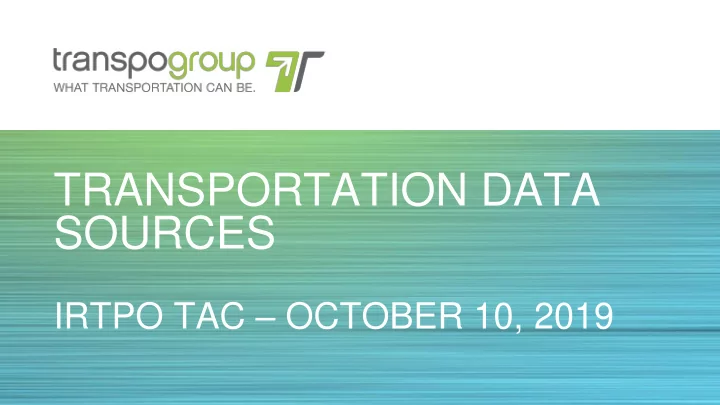

TRANSPORTATION DATA SOURCES IRTPO TAC – OCTOBER 10, 2019
PRESENTATION OVERVIEW • Goal is to introduce ‘new’ ways of collecting transportation data that can be used to benefit Island County planning efforts • Typical Data Collection Methods and their limitations • ‘New’ Methods: • INRIX • Streetlight Data • Others Data Sources • Google • Wejo • MioVision • Comparison Study • Q&A (please ask questions at any time)
TYPICAL METHODS OF DATA COLLECTION • Manual observations • Video Counts • Pneumatic Tube Counters • Floating Car Surveys • Bluetooth / WiFi Readers
TYPICAL METHODS OF DATA COLLECTION • Manual observations - cheap but limited scope of data, hard to scale • Video Counts - cheap but limited scope of data, hard to scale • Pneumatic Tube Counters - cheap, slightly more data, can be inaccurate, no O/D info • Floating Car Surveys - easy to understand, can get expensive, limited scope • Bluetooth / WiFi Readers - expensive, limited geography, requires hardware
TYPICAL METHODS OF DATA COLLECTION • Manual observations • These data sources have been the backbone of planning decision • making, and are mostly based on 1 Video Counts to 3 days of data • Pneumatic Tube Counters • Floating Car Surveys • Bluetooth / WiFi Readers
NEW DATA SOURCES • New data is based on location data • In vehicle systems (GPS) • Cell phones (GPS & LBS) • No Data Collection Time • No Roadside Equipment • Based on ‘representative sample’ of traffic • Data available for any time period Image from gis.stackexchange.com
INRIX INRIX Provides: Speed and Roadway Travel Times
INRIX • Types of Questions to ask: • How fast/slow do vehicles travel along a given roadway? • How do speeds vary throughout the day? • How do speeds vary by day of week, by month, by season, by year? • Where do slowdowns occur along a given roadway? • What happened during a specific roadway incident or period of congestion?
INRIX – SAMPLE SPEED DATA • INRIX Data – SHOW GRAPHICS - PAUL • On-board vehicle navigation • Allows for travel time / speed info • Starting to do O/D
INRIX – CONGESTION SCAN
INRIX – BOTTLENECK EVENTS • INRIX Data – SHOW GRAPHICS - PAUL • Strengths / Weaknesses
INRIX – DATA AVAILABILITY IN ISLAND COUNTY • Data Available across the county on major and minor roadways • Data typically not available for roadways with small daily traffic totals (local roads)
PROS & CONS OF INRIX • Pros • Offers historic and semi real-time data on travel time, speeds, and other congestion metrics • Combines real-time and historic data and offers a confidence interval for travel time and speed reports • Web based and requires no special hardware or software • Suitable for real-time traffic operations and management • Cons • XD Segments don’t always align with desired study roadway • Raw Data inaccessible – how many data points? • No Count Data – Only Speed Information available • Cost • Per Project (cost per roadway mile or given geography / time period)
STREETLIGHT DATA Image source: StreetlightData.com
STREETLIGHT DATA • Types of Questions to ask: • How many vehicles/ped/bikes/cars travel on a roadway? • Where do vehicles travel to/from on a given roadway? • Where do trucks travel to/from a specific location? • Where do pedestrian and bicycles travel to/from? • What routes do vehicles take to get between an origin and destination? • How do specific travel patterns change by hour, day of week, month, or seasonally?
STREETLIGHT DATA What roads do WB vehicles from SR 532 turn onto in the PM peak?
STREETLIGHT DATA • Where do vehicles entering Whidbey Island in the morning from ___ go? Clinton Ferry Coupeville Ferry Deception Pass
STREETLIGHT DATA • More detailed information available about the trips selected
PROS & CONS OF STREETLIGHT • Pros • Suitable for OD studies, historic travel time at 1-hour granularity level, and other planning studies • Enables insight into trip purpose and other metrics not available on other platforms • Able to estimate counts • Web based and requires no special hardware or software • Cons • Less suitable for real-time traffic operations and management • Provides no access to raw data or processing techniques • Requires knowledge of online user interface and analysis process • Cost • Subscription (annual fee for a specific geography) • Per Project (cost per analysis zone)
OTHER DATA SOURCES • Google Maps • Extract travel time and speed data from their platform using their API • Pricing based on per data unit • Wejo • Anonymized location data (include speed, direction) at 3 second intervals provided directly by vehicle OEMs • GM and others • MioVision (intersection based) • Plug in to traffic cabinet and camera • Video AI counts, access via web app
IRVINE, CA – CASE STUDY
IRVINE – CASE STUDY Travel Time Comparison 400 350 300 Travel Time (sec) 250 200 150 100 50 0 0:00 2:30 5:00 7:30 10:00 12:30 15:00 17:30 20:00 22:30 Blue Toad Inrix Google Maps Streetlight
SUMMARY • Many new platforms and ways to access transportation data • Pros and cons to each – but flexible to meet different needs • These new data sources provide larger windows of data • Allows for more flexible ways to view the data • Data availability is constantly improving • Some platform require analytic skills, some are very user friendly • Data may not be as expensive as you think
Q&A THANK YOU Paul Sharman, PE Transportation Engineer 425.896.5262 Paul.Sharman@transpogroup.com
Recommend
More recommend